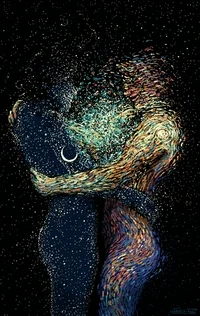Before we start with the
discussion of the various parts of the horoscope which collectively determine
the occupation a brief description of the horoscope may not be out of place at
this stage. In order to make this work both interesting and instructive even to
absolutely lay reader important preliminary information regarding the horoscope
is furnished herewith. Every effort is made to make this description as brief
and simple as possible so that the space allotted thereto may be reduced to the
minimum possible. The system we follow is the Indian System of Astrology which
is known as the Nirayana system.
The horoscope consists of
12 houses and each house contains one of the signs or Rasis which are 12 in
numbers. They are as under:-
1. Mesha (Aries)
2. Vrisham (Taurus)
3. Mithun (Gemini)
4. Kark (Cancer)
5. Sinha (Leo)
6. Kanya (Virgo)
7. Tula (Libra)
8. Vrischika (Scorpio)
9. Dhanu (Sagittarius)
10. Marka (Capricorn)
11. Kumbha (Aquarius)
12. Meenam (Pisces)
Each sign contains 30
degrees; each degree is divided into 60 minutes and each minute is further
divided into 60 seconds.
Each sign is divided into
Nakshatras and each Nakshatra is further divided into Padams which are four in
number. A Nakshatra contains 13 degrees and 20 minutes and a Padam contains 3
degrees and 20 minutes. There are 2 ¼ Nakshatras and 9 Padams is one sign or
Rasi. There are 9 Planets or Grahas which are as under:-
1. Surya (Sun)
2. Chandra (Moon)
3. Buddha (Mercury)
4. Shukra (Venus)
5. Mangal (Mars)
6. Guru (Jupiter)
7. Shani (Saturn)
8. Rahu (Ascending Node or
Dragon’s Head)
9. Ketu (Descending Node
or Dragon’s Tail)
The Surya (Sun) owns Simha
(Leo); the Chandra (Moon) rules Kark (Cancer); The Budha (Mercury) owns Mithun
(Gemini) and Kanya (Virgo); The Shukra (Venus) rules Vrisham (Taurus) and Tula
(Libra). The Mangal (Mars) owns Mesha (Aries) and Vrischika (Scorpio); The Guru
(Jupiter) owns Dhanu (Sagittarius) and Meenam (Pisces); The Shani (Saturn)
rules Makra (Capricorn) and Kumbha (Aquarius), Rahu and Ketu do not rule or own
any sign or Rasi.
The Surya (Sun) enjoys
exaltation in Mesha (Aries) and suffers debilitation in Tula (Libra); the
Chandra (Moon) is exalted in Vrisham (Taurus) and debilitated in Vrischika
(Scorpio); The Buddha (Mercury) is exalted in Kanya (Virgo) which it owns also
and is debilitated in Meenam (Pisces); The Mangal (Mars) gets exalted in Makra
(Capricorn) and it is debilitated in Kark (Cancer). The Shukra (Venus) enjoys
exaltation in Meenam (Pisces) and suffers debilitation in Kanya (Virgo). The
Shani (Saturn) is exalted in Tula (Libra) and debilitated in Mesha (Aries).
For the Surya (sun) Kumbha
(Aquarius) is the house of an enemy; for the Chandra (Moon) Makra (Capricorn)
is the house of an enemy; for the Buddha (Mercury) Dhanu (Sagittarius) and
Meenam (Pisces) are the houses of an enemy; Mesha (Aries) and Vrischika
(Scorpio) are enemy’s houses for the Shukra (Venus). Vrisham (Taurus) and Tula
(Libra) are enemy’s houses for the Mangal (Mars); Mithun (Gemini) and Kanya
(Virgo) are enemy’s houses for the Guru (Jupiter); Karak (Cancer) and Simha
(Leo) are enemy’s houses for the Shani (Saturn). A Planet is said to aspect
fully a house and any Planet therein if the house in question is 7th
from the house which contains the aspecting Planet. The aspect is only 75% if
the house aspected is 4th or 8th from the house
containing the aspecting Planet. The aspect is 50% if the house aspected is 5th
or 9th from the house containing the aspecting Planet. And the aspect
is bare 25% if the house aspected is 3rd or 10th from the
house containing the aspecting Planet.
There are three exceptions
to these rules. The first one relates to the Guru (Jupiter). The Guru (Jupiter)
aspects fully not only the 7th house as counted from the house it
occupies but also the 5th and the 9th house as counted
from the house it occupies.
The second exception
relates to the Shani (Saturn). Shani (Saturn) aspects fully not only the 7th
house as counted from the house it occupies but also the 3rd and the
10th houses as counted from the house it occupies.
The third exception
relates to the Mangal (Mars). The Mangal (Mars) fully aspects not only the 7th
house from the house it occupies but also the 4th and the 8th
houses as counted from the house it occupies.
The Planet are said to be
in Sambandhan if they fully aspect each other. They are also said to be in
Sambandhan if they exchange houses with each planet. These Planets are also
said to be in Parivartan Yoga. If a Planet fully aspects another Planet and the
aspecting Planet is in the sign of the aspected Planet both the Planets are
said to be in Sambandhan. Again if a Planet fully aspects anbother Planet and
the aspected Planet is in the sign of the aspecting Planet, both the Planets
are said to be in Sambandhan.
The 1st, 4th,
7th and 10th houses are called the Kendras and the 1st,
5th and 9th houses are called the Trines. A Navamsa is
one-ninth of a sign, i.e., Rasi and it is equal to 3 degrees and 20 minutes. In
Meshas (Aries) we start counting Navamsa with Meshas (Aries); in other words it
means that in Mesha (Aries) the 1st Navamsa is Mesha (Aries) itself.
We start counting with Mesha (Aries) and count upto Dhanu (Sagittarius) in
Mesha (Aries). We have reached Vrisham (Taurus). In Vrisham (TaurusA) we start
counting with Makra (Capricorn) and finish with Kanya (Virgo). Next to Vrisham
(Taurus) is Mithun (Gemini). In Mithun (Gemini) the counting starts with Tula
(Libra) and ends in Mithun (Gemini). In Kark (Cancer) the 1st
Navamsa is Kark (Cancer) itself and the last one is Meenam (Pisces). In Sinha
(Leo) we start again with Meshas (Aries) and in Vrischika (Scorpio) we again
finish with Meenam (Pisces). Dhanu (Sagittarius) once again starts with Mesha
(Aries) and Meenam (Pisces) once again ends with Meenam (Pisces) itself. For
the purpose of calculating the Navamsa we may group the signs as under:-
Meshas (Aries), Simha
(Leo) and Dhanu (Sagittarius) start with Meshas (Aries) Navamsa and ends in
Dhanu (Sagittarius) Navamsa.
Vrisham (Taurus), Kanya (Virgo)
and Makra (Capricorn) start with Makra (Capricorn) Navamsa and ends with Kanya
(Virgo) Navamsa.
Mithun (Gemini), Tula
(Libra) and Kumbha (Aquarius) start with Tula (Libra) Navamsa and end in Mithun
(Gemini) Navamsa.
Kark (Cancer), Vrischika
(Scorpio) and Meenam (Pisces) start with Kark (Cancer) Navamsa and end in
Meenam (Pisces) Navamsa.
The following is the chart
of Nakshatras and their lords.
Degree
|
Mesha
(Aries) |
Sinha
(Leo) |
Dhanu
(Sagittarius) |
|
00.00-13.20
|
Ashvini
|
Megha
|
Moola
|
Ketu
|
13.20-26.40
|
Bharani
|
Purva
Phalguni |
Purva
Shadha |
Shukra
|
26.40-30.00
|
Krittika
|
Uttara
Phalguni |
Uttara
Shadha |
Surya
|
Vrisham
(Taurus) |
Kanya
(Virgo) |
Makra
(Capricorn) |
||
00.00-10.00
|
Krittika
|
Uttara
Phalguni |
Uttara
Shadha |
Surya
|
10.00-23.20
|
Rohini
|
Hasta
|
Sharvana
|
Chandra
|
Mrigashirsha
|
Chitra
|
Dhanishta
|
Mangal
|
|
23.20-30.00
|
Mithuna
|
Tula
|
Kumbha
|
|
00.00-06.40
|
Mrigshirsha
|
Chitra
|
Dhanishta
|
Mangal
|
06.40-20.00
|
Aadra
|
Svati
|
Satabhisha
|
Rahu
|
20.00-30.00
|
Punarvasu
|
Vishaka
|
Purva
Bhadra |
Guru
|
Kark
(Cancer) |
Vrischika
(Scorpio) |
Meenam
(Pisces) |
||
00.00-03.20
|
Punarvasu
|
Vishaka
|
Purva
Bhadra |
Guru
|
03.20-16.40
|
Pushya
|
Anuradha
|
Uttara
Bhadra |
Shani
|
16.40-30.00
|
Ashlesha
|
Jyeshta
|
Revati
|
Budha
|
The Yoga Karaka is the
Planet which rules a Kendra and a Trine. If two planets find themselves in the
same sign and house they are said to conjoin each other.
Dosha means a
disqualification. A Planet which suffers some disqualification is said to be
under a Dosha.
The Upachaya houses are
the 3rd, 6th, 10th and 11th houses
and they are deemed auspicious and favourable. It is a qualification for a
Planet to own, occupy and/or aspect one or more of Upachaya houses.
The Dusthana houses are
the 6th, 8th and 12th houses and they are
deemed evil, hostile and harmful. A Planet which rules or/and occupies any of
these houses is said to be under a Dosha and the Planet in question damages the
house with which it is associated at the same time. The 6th house,
it may be noted, is included both in the Upachaya and Dusthana houses. The 6th
house is, therefore, of a very elusive nature and to judge its significance
correctly exercises to a very great extent the discretion of the Astrologer.
The 6th house improves its qualification if it finds itself
associated with a good house. The planet A is said to be the dispositor of the
Planet B if the Planet B happens to occupy the sign and the house owned by the
Planet A.
Significator is the noun
derived from the verb `signify’. Thus the significator of occupation means
something which signifies, indicates and represents the occupation and the
planetary significator of occupation means the Planet which signifies and
represents the occupation.
The Karka is the Sanskrit
equivalent of the word “significator” to a certain extent. The Karka means many
things more and one of them is meant to convey the sense which the word
insignificator does. Regarding the friends and enemies among the Planets it may
be asserted that the Planets also own natural friendship and enmity with each
other. The Sun (Surya) and the Saturn (Shani) are enemies and so are the Mars
(Magal) and the Venus (Shukra). The Jupiter (Guru) and Mercury (Buddha) are
also enemies to each other.
The Sun (Surya) is
friendly to Mars (Mangal), the Venus (Shukra) to the Jupiter (Guru), the Mars
(Mangal) to the Saturn (Shani), the Saturn (Shani) to the Venus (Shukra) and
the Jupiter (Guru) to the Moon (Chandra).
The debilitation of a
Planet stands cancelled if the lord of the sign the Planet in question occupies
is in a Kendra from the Lagna or the Chandra-lagna.
The debilitation of a
Planet also stands cancelled if the lord of the sign of exaltation of the said
planet is in a Kendra from the Lagna or the Chandra-lagna.
The debilitation of a
Planet stands cancelled also if its dispositor fully aspects the Planet in
question. The debilitation of a Planet is cancelled if the lords of the signs
of debilitation and exaltation of the Planet in question conjoin or oppose each
other or if they are at a distance of 4 houses or 10 houses from each other.
The debilitation of a
Planet stands cancelled also if the Planet in question is Retrograde, i.e., it
is moving in the reverse direction. A Retrograde Planet is exhibited in the
horoscope with the word R.
The Malefics are evil
Planets or the Papa Grahas: They are the Mangal and the Shani. The Surya is also
branded as a Papa graham. A Buddha associated with the Malefics is deemed a
Papa Graha.
The Benefics are good
Planets or the Shubha Grahas. They are the Guru and the Shukra. A Buddha
associated with the Benefics is deemed a Shubha Graha.
Exaltation is a
qualification. An exalted Planet or a Planet in exaltation is deemed strong.
Debilitation is a
disqualification. A debilitated Planet or a Planet in its debilitation is
deemed weak.
The 2nd, 7th,
8th and the 12th houses from the Lagna or the
Chandra-lagna are called maraca places and the Dosha of a Planet ruling any one
of the houses mentioned above is deemed serious.
Dr. Shanker Adawal
Profile and Dr. Adawal’s Astro
Channel
Dr. Adawal’s research work and
articles on Bhrigu Nadi astrology
Dr. Adawal’s approved articles
published on Articlesbase.com
Dr. Adawal’s exclusive articles
on docstoc.com
https://www.facebook.com/groups/Astrology.Fan.Club/
https://www.facebook.com/groups/Astrology.Fan.Club/
Join Dr. Adawal’s Facebook Group
for free Astro Queries















































No comments:
Post a Comment